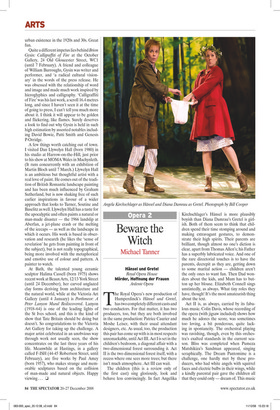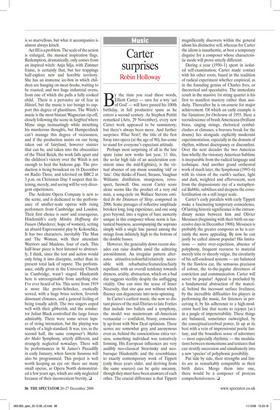Beware the Witch
Michael Tanner
Hänsel und Gretel Royal Opera House Mörder, Hoffnuniq der Frauen Ardente Opera
The Royal Opera’s new production of Humperdinck’s Hänsel und Gretel, has two completely different casts and two conductors. For that matter, it has two producers, too, but they are both involved in the same production: Patrice Caurier and Moshe Leiser, with their usual attendant designers, etc. As usual, too, the production this pair has come up with is in most respects unremarkable, until Act III. Act I is set in the children’s bedroom, a diagonal affair with a two-dimensional forest surrounding it. Act II is the two dimensional forest itself, with a recess where one sees more trees; but there isn’t much atmosphere. Act III can wait.
The children (this is a review only of the first cast) sing gloriously, look and behave less convincingly. In fact Angelika Kirchschlager’s Hänsel is more plausibly boyish than Diana Damrau’s Gretel is girlish. Both of them seem to think that children spend their time stomping around and making extravagant gestures, to demonstrate their high spirits. Their parents are brilliant, though almost no one’s diction is clear, apart from Thomas Allen’s; his Father has a superbly lubricated voice. And one of the rare directorial touches is to have the parents, decrepit as they are, getting down to some marital action — children aren’t the only ones to want fun. Then Dad wonders about the kids, and Mum has to button up her blouse. Elizabeth Connell sings unstintedly, as always. What tiny roles they have, though! It’s the most amateurish thing about the text.
Act II is, as always, carried by its fabulous music. Colin Davis, whose recording of the opera (with jigsaw included) shows how much he adores the score, was sometimes too loving, a bit ponderous, quite lacking in spontaneity. The orchestral playing was ravishing, though, even by this orchestra’s exalted standards in the current season. Bliss was completed when Pumeza Matshikiza’s Sandman appeared, singing seraphically. The Dream Pantomime is a challenge, one hardly met by these producers, who had white angels with squirrel faces and electric bulbs in their wings, while a kindly parental pair gave the children all that they could only — dream of. This music is so marvellous, but what it accompanies is almost always kitsch.
Act III is a problem. The scale of the action is enlarged, the musical inspiration flags. Redemption, dramatically, only comes from an inspired witch: Anja Silja, with Zimmer frame, is certainly that, but her trappings half-explore new and horrible territory. She has an immense ice-box in which children are hanging on meat-hooks, waiting to be roasted; and two huge industrial ovens, from one of which she pulls a fully cooked child. There is a pervasive air of fear in Hänsel, but the music is too benign to support this degree of ghastliness. The Witch’s music is the most blatant Wagnerian rip-off, closely following the scene in Siegfried where Mime sings insinuatingly while mouthing his murderous thoughts, but Humperdinck can’t manage this degree of viciousness, and if the production insists on our being taken out of fairyland, however sinister that can be, and taken into the obscenities of the Third Reich, the work falls apart and the children’s victory over the Witch is not enough to heal the hideous gap. The production is being broadcast on 16 December on Radio Three, and televised on BBC2 at 3 p.m. on Christmas Day: I suspect that listening, merely, and seeing will be very divergent experiences.
The Ardente Opera Company is new to the scene, and is dedicated to the performance of smaller-scale operas with rising performers from Cambridge and London. Their first choice is outré and courageous, Hindemith’s early Mörder, Hoffnung der Frauen (Murderer, hope of women), setting an absurd Expressionist play by Kokoschka. It has two characters, inevitably The Man and The Woman, with their attendant Warriors and Maidens, four of each. This half-hour piece is best listened to abstractly, I think, since the text and action would only bring it into disrepute, rather than its present total lack of repute. The performance, oddly given in the University Church in Cambridge, wasn’t staged. Hindemith here is unrecognisable from anything else I’ve ever heard of his. This score from 1919 is more like proto-Schreker, exotically scored, with a huge brass section, feverish dissonant climaxes, and a general feeling of being tonally adrift. The two singers coped well with their gibberish, and the conductor Julian Black controlled the large forces admirably. There were some severe lapses of string intonation, but the playing was mainly of a high standard. It was, too, in the second half, the same composer’s Mathis der Maler Symphony, utterly different, and strangely neglected nowadays. There will be performances in St James’s Piccadilly in early January, when Sancta Susanna will also be programmed. This project is well worth keeping an eye on: there are many small operas, as Opera North demonstrated a few years ago, which are only neglected because of their inconvenient brevity. ❑























































































































 Previous page
Previous page